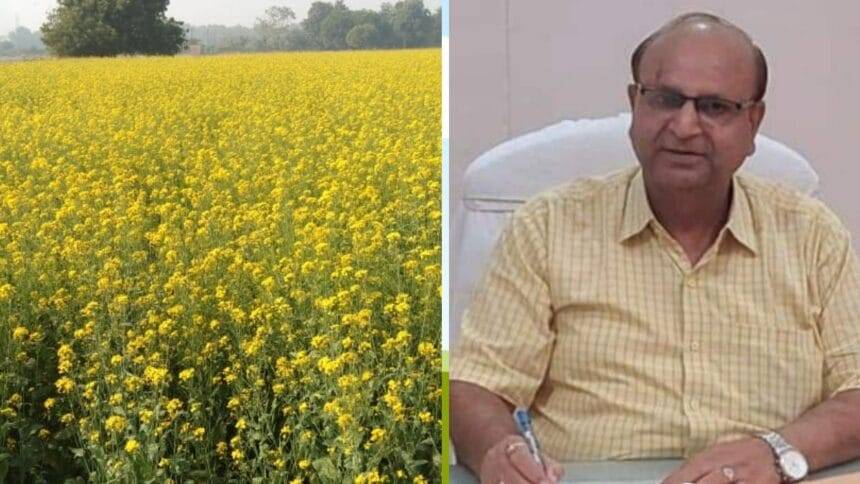Main Points In Hindi (मुख्य बातें – हिंदी में)
-
नई सरसों की किस्म: नई सरसों की किस्म जो 7% अधिक तेल प्रदान करती है, किसानो को आय में वृद्धि के अवसर प्रदान करेगी। यह किस्म 7.81% अधिक उपज भी देगी।
-
भारत में सरसों का उत्पादन: भारत वर्तमान में विश्व में तीसरा सबसे बड़ा सरसों उत्पादक और सातवाँ सबसे बड़ा सरसों तेल निर्यातक है। उत्तर प्रदेश में सरसों की कुल खेती क्षेत्र 7.53 लाख हेक्टेयर है, जिसमें लगभग 11.53 लाख मीट्रिक टन उत्पादन होता है।
-
उपयुक्त किस्में और समय: विश्वविद्यालय द्वारा विकसित नई किस्में जैसे ‘आज़ाद मेहक’ और ‘आज़ाद चेतना’ अधिक लाभ प्रदान करने के लिए उपयुक्त हैं। अक्टूबर का महीना बुवाई के लिए सर्वोत्तम है, लेकिन यदि देरी हो जाए तो 1 से 25 नवंबर के बीच भी बुवाई की जा सकती है।
-
विभिन्न स्वास्थ्य लाभ: सरसों का तेल कई स्वास्थ्य लाभ प्रदान करता है, जैसे हृदय स्वास्थ्य, मधुमेह नियंत्रण, और कैंसर से लड़ने में मदद करना। इसके अलावा, सरसों की खली (cake) को पशु चारे के रूप में प्रयोग किया जाता है, जिसमें 38 से 40% प्रोटीन होता है।
- उपज क्षमता: यदि सरसों की खेती के दौरान मौसम अनुकूल रहता है और फसल रोगों और खरपतवार से मुक्त रहती है, तो प्रति हेक्टेयर उत्पादन 25-30 क्विंटल तक पहुँच सकता है।
Main Points In English(मुख्य बातें – अंग्रेज़ी में)
Here are the main points from the provided text about the new variety of mustard:
-
Increased Oil Content and Yield: The new variety of mustard developed offers 7% more oil and a 7.81% higher yield, which is expected to significantly improve farmers’ profitability.
-
Importance in Agriculture: Mustard is a vital crop in India, ranking third in production and seventh in export globally. Oilseed crops, including mustard, play a crucial role in the national agricultural economy.
-
Recommended Varieties for Sowing: The university has developed various mustard varieties such as Azad Mehak, Azad Chetna, Varuna, and Vaibhav, with specific recommendations for sowing times (October to November 25) and conditions (semi-arid regions).
-
Health and Nutritional Benefits: Mustard oil is recognized for its health benefits, including improving heart health and controlling diabetes. The residual cake from mustard processing is high in protein (38-40%) and is beneficial for animal feed.
- Potential Yield: Under optimal conditions, the yield of mustard can reach 25-30 quintals per hectare, contingent on favorable climate and absence of diseases or weeds.


Complete News In Hindi(पूरी खबर – हिंदी में)
नई प्रकार की सरसों, जो सात प्रतिशत अधिक तेल देती है, आने वाले दिनों में किसानों को अमीर बना सकती है। इस प्रकार में न केवल अधिक तेल होता है बल्कि यह 7.81 प्रतिशत अधिक उपज भी देती है। इस विषय में डॉ. मेहक सिंह, चंद्रशेखर आजाद कृषि और प्रौद्योगिकी विश्वविद्यालय (सीएसए), कानपुर के तेलबीज विभाग के वरिष्ठ प्रोफेसर ने कहा कि राई सरसों एक महत्वपूर्ण फसल है। उन्होंने कहा कि तेलबीज फसलें राष्ट्रीय कृषि अर्थव्यवस्था में दूसरे स्थान पर हैं।
पीतांबरी पीली सरसों की मुख्य प्रजाति है।
डॉ. सिंह ने आगे कहा कि भारत, कनाडा और चीन के बाद, विश्व स्तर पर तीसरा सबसे बड़ा सरसों का उत्पादक और सातवां सरसों का तेल निर्यातक है। उत्तर प्रदेश में सरसों का कुल क्षेत्र लगभग 7.53 लाख हेक्टेयर है और कुल उत्पादन लगभग 11.53 लाख मीट्रिक टन है। विश्वविद्यालय द्वारा विकसित प्रमुख सरसों की प्रजातियाँ हैं: वरुण, वैभव, रोहिणी, माया, कांती, वर्धन, आशीर्वाद और बसंती। जबकि पीतांबरी पीली सरसों की मुख्य प्रजाति है।
सरसों उगाकर अधिक लाभ कमाएँ
डॉ. मेहक सिंह बताते हैं कि विश्वविद्यालय ने सरसों की नई प्रजातियाँ जैसे आजाद मेहक और आजाद चेतना विकसित की हैं। वरुण और वैभव प्रजातियाँ अर्ध-शुष्क परिस्थितियों में बोने के लिए सबसे अच्छी मानी जाती हैं। उन्होंने कहा कि अक्टूबर का महीना बोने का सबसे अच्छा समय है, और यदि देरी होती है तो 1 से 25 नवंबर का समय सही है।
वरुण प्रजाति में मोटे बीज और अधिक तेल होता है।
डॉ. सिंह ने कहा कि विश्वविद्यालय द्वारा विकसित राई सरसों की प्रजातियाँ देश भर में उगाई जा रही हैं। जबकि वरुण प्रजाति को सिंचित और असिंचित दोनों स्थितियों के लिए अनुशंसित किया गया है और यह बदलती जलवायु में तापमान के प्रति सहिष्णु है। अन्य प्रजातियों की तुलना में इन्हें बीमारियाँ कम होती हैं। उन्होंने बताया कि वरुण प्रजाति के बीज मोटे होते हैं और इसमें तेल का उच्च प्रतिशत 39 से 41.8% होता है। सरसों का तेल मानव स्वास्थ्य के लिए कई प्रकार से फायदेमंद है।
पशु आहार के लिए भी लाभकारी
डॉ. मेहक सिंह बताते हैं कि सरसों का तेल एक स्वास्थ्य टॉनिक के रूप में, रक्त निर्माण में, हृदय को स्वस्थ रखने में, मधुमेह को नियंत्रित करने में, कैंसर से लड़ने में, एंटी-बैक्टीरियल और एंटी-फंगल गुणों के कारण, जुकाम और खांसी से राहत देने में, जोड़ों के दर्द और दमा के उपचार में इस्तेमाल होता है। उन्होंने कहा कि सरसों से निकलने वाला ठोस अवशेष ‘केक’ कहलाता है। इसमें 38 से 40% प्रोटीन होता है, जो पशु आहार में इस्तेमाल होता है, जिससे जानवरों को लाभ मिलता है। हमें यह बताना चाहिए कि सरसों को सबसे महत्वपूर्ण रबी फसलों में से एक माना जाता है।
उपज कितनी होगी
यदि आप सरसों की खेती कर रहे हैं और इस दौरान मौसम अच्छा रहा, कोई प्राकृतिक आपदा का खतरा नहीं है, और फसल रोग और杂草 से मुक्त है, तो उत्पादन 25-30 क्विंटल प्रति हेक्टेयर तक हो सकता है।
Complete News In English(पूरी खबर – अंग्रेज़ी में)
The new variety of mustard which gives seven percent more oil will make the farmers rich in the coming days. This variety not only has more oil content but will also yield 7.81 percent more. In this matter, Dr. Mehak Singh, senior professor of oilseeds section of Chandrashekhar Azad University of Agriculture and Technology (CSA), Kanpur, said that rye mustard is an important crop. He said that oilseed crops occupy the second place in the national agricultural economy.
Pitambari is the main species in yellow mustard.
Dr Singh further said that India is the third major mustard producer and seventh mustard oil exporter after Canada and China at the global level. The total area of mustard-mustard in Uttar Pradesh is about 7.53 lakh hectares and the total production is about 11.53 lakh metric tons. Major varieties of mustard developed by the university are Varuna, Vaibhav, Rohini, Maya, Kanti, Vardaan, Ashirwad and Basanti. Whereas Pitambari is the main variety in yellow mustard.
Sow mustard for bumper profits
Dr. Mehak Singh tells that the university has developed new varieties like Azad Mehak of mustard and Azad Chetna of mustard, Govardhan. Whereas varieties like Varuna and Vaibhav are best for sowing in semi-arid conditions. He said that the month of October is the best time for sowing, and in case of delay, November 1 to November 25 is best.
Varuna variety has thicker grains and more oil content.
Dr Singh said that the rye mustard species developed by the university is being grown all over the country. Whereas Varuna variety is recommended for both irrigated and non-irrigated conditions and is also tolerant to temperature in changing climate. Compared to other species, they suffer less from diseases. He told that the grain of Varuna variety is thick and the oil content is high at 39 to 41.8%. Mustard oil benefits human health in many ways.
Also beneficial for animal feed
Dr. Mehak Singh says that mustard oil is used as a health tonic, helps in blood formation, healthy heart, controls diabetes, cancer fighter, anti-bacterial and anti-fungal, cold and cough reliever, joint pain and cough remedy and asthma reliever. Is used in. He told that the residual solid substance coming out of mustard is called cake. 38 to 40% protein is found in cake, which is used in animal feed, which benefits the animals. Let us tell you that mustard is considered one of the most important Rabi crops.
the yield will be this much
If you are cultivating mustard. During this period the climate remained fine. There is no threat of any kind of natural disaster. If the crop remains free from diseases and weeds, then the production can be up to 25-30 quintals per hectare.








